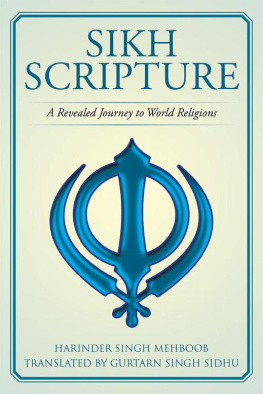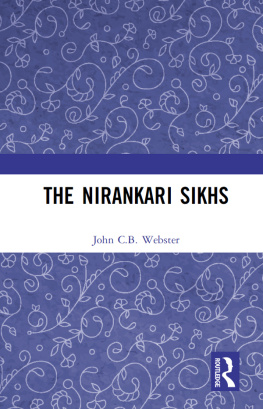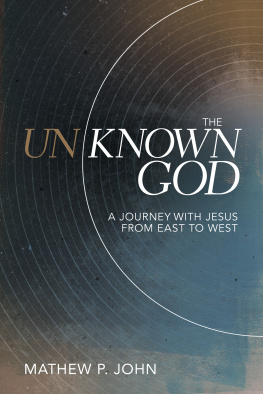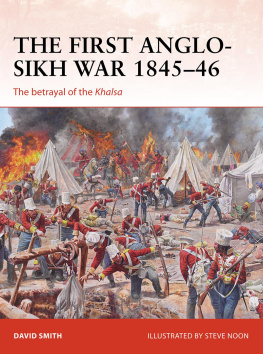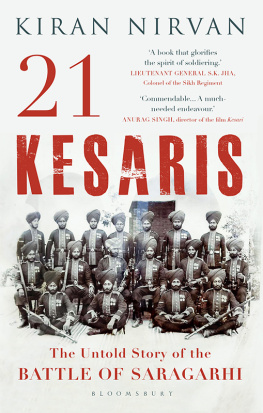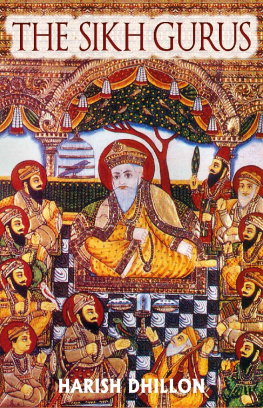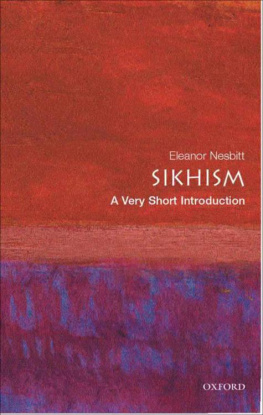Sikh Scripture
A Revealed Journey to World Religions
Harinder Singh Mehboob
Translated by Gurtarn Singh Sidhu
Copyright 2015 by Harinder Singh Mehboob.
Library of Congress Control Number: 2015902947
ISBN: Hardcover 978-1-5035-4659-2
Softcover 978-1-5035-4660-8
eBook 978-1-5035-4661-5
All rights reserved. No part of this book may be reproduced or transmitted in any form or by any means, electronic or mechanical, including photocopying, recording, or by any information storage and retrieval system, without permission in writing from the copyright owner.
Sikh symbol - Khanda, blue with dark edges photo by Hari Singh taken from Flickr.com licensed under CC BY 2.0
khanda - orange photo by Hari Singh taken from Flickr.com licensed under CC BY 2.0
Any people depicted in stock imagery provided by Thinkstock are models, and such images are being used for illustrative purposes only.
Certain stock imagery Thinkstock.
Rev. date: 02/24/2015
Xlibris
1-888-795-4274
www.Xlibris.com
697723
Contents
First Dedication
Dedicated to my dear friend of childhood, Dr. Gurtarn Singh of Panjabi University, Patiala, with whom in Chak No. 233 (Lyallpur) Pakistan, Ranchana (Rajindrapuri Puri), and in the village Jhundan (India) are assembled countless silent reminiscences of innocent days (first publication, 1979).
Second Dedication
Dedicated again to my dear friend Gurtarn Singh in whose rise and fall of my friendship I sometimes look at my countless footprints effaced and at other times shining (Vesakhi, April 1999).
Thanks to S. Fakir Singh (chairman of Harinder Singh Mehboob Trust); S. Gurdial Singh Sarain; Daljit Singh Shalapuri; Dr. Satwant Kaur (daughter of Harinder Singh Mehboob); S. Baljinder Singh Balli; S. Perminder Singh Sahota; Sukhvir Singh (from the family of the writer); Dr. Balwinder Kaur Bariana; S. Chetan Singh (director of Languages Department, Patiala); Harjas Preet Kaur and Gurpreet Kaur Patiala, who remain a permanent inspiration for me; S. Parmpreet Singh Pannu, S. Randeep Singh Sandhu who gave help in publishing the book with missionary excitement.
My son Sartaj Singh, daughter-in-law Navkiran Kaur, granddaughter Rabbea and grandson Arman; my wife Harminder Kaur; and Balbir Singh Attwal (son-in-law) and my daughter Gulnaz and Sammi.
I am essentially thankful from my heart to the director and other members of the Xlibris Press who have been giving me warm cooperation to complete my manuscript in the proper way. After the publication of the book, I expect our relations to be always profound and that it will enhance wisdom on both sides with sufficient progress, helping to emanate warm relations with scholars and students of religions and other forms of literature all over the world.
Preface
(A brief summary of the life of the writer and Sehje rachio Khalsa [ A Revealed Journey to World Religions ])
The entire life of the writer Harinder Singh Mehboob, from October 1, 1937, to February 14, 2010, was a rare epical life. As we touch the ocean from anywhere, it is all water, in the same mode that every footprint of the poet was a complete epic from start, middle, and end. Before the partition of India and Pakistan in 1947, which was filled with deep pain, the birth of the writer took place in village Chak No. 233, district Lyallpur in Sandal Bar (An artistic land gifted with primordial grace). This land of Sandal Bar has maintained the period of Adam through the response of pure nature, its simple and innocent wild people of ancient variety, the old stories of its true lovers who were swooned in their death in love, Punjabi Sufi poets, and through the labor of these true, simple, and innocent people with spontaneous kindness. The poets village Chak No. 233 is near the village of Talwandi, which is the birthplace of the first prophet of the Sikh Nation (Khalsa), Guru Nanak Sahib. This place is the meeting point of Semitic prophets, Islam, and also the Indian Avataras with the collective grace of Indian and Islamic traditions blessed with the wisdom of ancient classical melody. At the time of the birth of the poet Harinder Singh Mehboob, this land flourished with the ancient wisdom of the primordial people known as Janglis. So it was an ancient nest of gentry that maintained the reminiscences of the Garden of Eden. The legends of its lovers Heer-Ranja, Sasi-Punu, Sohni-Mehiwal, Mirza-Sahiban, and Shirin-Farhad, etc., are, in the words of Earnest Rhys, like the prophets of the Old Testament, Solomon and Ruth. Harinder Singh Mehboob, in his book of divine poetry Jhana di rat , has glorified their beauty in marvelous variety:
Jis de joban jal bal jana
Heer na os bunare
Rang kasumbha jis than vikda
Os ton khari agare.
Je na wang ambar the tute
Joban Heer da wallan
Sanjog-weyog dian watan te
Mar riha wad shallan.
(Heer is not standing upon such parapet which is perishable, the worldly way upon which the decaying things which are fragile (In the hymn of Bhagat) like safflower are valued. She is standing further untouched from its devastating approach. If the bangle of the heaven may not break and tolerate its thunder like vibration of beauty and ecstasy then we may encircle the phantom-like prime of Heer, which is overflowing upon the ways of meeting and separation like the billows of the river Jhanan.)
In the words of the twentieth-century Sikh poet Puran Singh: To maintain the freshness and the primeval grace of any religion, the people should live like these Janglis (primordial people). The Panjabi Sufi poets like Shaikh Farid, Data Ganj Huzviri, Syn Bullah Shaw, Shaw Husan, Sultan Bahu, Hashim, Waris Shaw, and Khawaja Gulam Farid, etc., are spiritually enlightened Panjabi poets with their distinctive fakir personalities. At this period, Islamic grace was dominating in the religious field of this sacred area.
This area was newly inhabited by the British government, which was very thankful especially to the Sikhs who participated on its behalf in the Second World War. Therefore the basic marks of primordial period were completely safe in the form of different arts in this pure nature and its people. At a distance of not more than ten miles from this village of the poet was the sacred village named Talwandi of Rai Bular, which was in district Shaikhupura. In that village, the first guru/prophet Guru Nanak was born in November 1469, who is the last prophet of this world. The highly valuable reminiscences of this gifted earth are the inseparable part of his poetic feelings. In 1947, when India and Pakistan were portioned, the writer had to leave this Garden of Eden with its matchless heritage. The political leaders of that period that had conspired to divide India and Pakistan had done so according to their hidden jealousy, dividing it mercilessly and with such intrigue that the spiritual reminiscences of this earth of the great Sikh Nation of the world were torn and separated permanently from the Sikhs and that the essential heart of the writer was eternally abraded. The following is from the preface of the long epical poem of the writer titled The Wailing Caravans . To give citation is proper here.
Though the poem uses as the symbols of great truths of those tragic happenings of assassins, to which the poet has seen and tolerated in his early age, but in the subtle reasoning of the poem are invisible the histories of the destines of nations . From the times of the exodus of Israelites from Egypt up to the injustices with the Sikhs and Palestine people, the history has repeated hundreds of such episodes of people to be deprived of their home land.
After the partition of 1947, when the writer was barely ten years old, he at first settled in the village of Ranchana/Rajindrapuri, in the Eastern Punjab of India. He lived here approximately for three to four years. After that, the poet came with his farmer family in the village Jhundan of the same Tehsil Malerkotla where he lived permanently. Because of the generosity of the writer, the Sikh Gurdwara and mosque of this village are at the same place. In the poetry of the poet, the different sights of the devastation of this orphan mosque, filled with the pain of separation and apathy, are present in a variety of colors.
Next page
